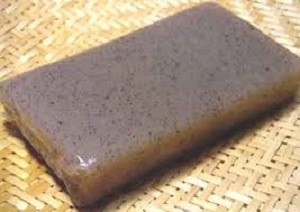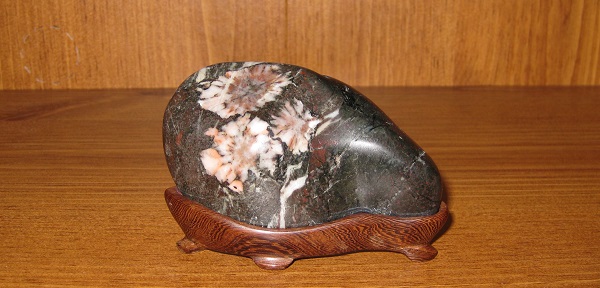Read Part One: On our Way to Tanigumi Kegonji
After hours of driving and having found the Tanigumi Kegonji temple parking lot, we tumble out of the car. We’re glad to ease our legs which are cramped from sitting so long. We’re all hungry, too. Lining the long, leafy promenade that stretches uphill toward the temple Tanigumi Kegonji, numerous restaurants entice us.
Of all the possibilities calling to my nostrils from the avenue, alas, my friends choose konnyaku imo (potato) on a stick. (Something blogger Chuck Clenney called a “gray starchy blob of tastelessness.” That’s so bang on I’ve purloined it). I could weep.
Although it can be eaten raw, boiled, fried and in many forms; this high-fibre, zero-calorie, rubbery “food” has no nutritional value. Zero. No good for anything sustaining at all–if you are hungry—which I am.
Banned in the EU after killing people who’ve choked on it or risked malnutrition from eating it excessively, konnyaku has no taste except that which it absorbs from the sauces or items accompanying it. However, konnyaku is popular with dieters because it makes them feel full while its fibre gives the intestines a good scrub.
The dark sauce slathered over the 3 grilled pieces sitting like dismal fudgesicles on my paper plate is excessively salty and sweet. I do my best to conceal my dismay and look appreciative, but I’m afraid that I am less than convincing. Since our experience so far seems to indicate that we are on a quest with mythological overtones, I remind myself that privation is part of the archetypal journey.
After “lunch” we work our way up the steady incline toward the temple. At one of several shops with kika seki (chrysanthemum stones) on display my friend insists on purchasing a souvenir for me. Cut and polished from basaltic rock which contains xenotime (a phosphate mineral) and zircon, kika seki reveal highly prized, flower-like configurations resembling chrysanthemums, the Imperial flower of Japan.
I am aghast. Even small stones the size of a child’s fist cost hundreds of dollars. Some, thousands. How can I accept?
I demur, do my best to beg off and protest that photos are enough; however, he insists. So I choose several of the smallest ones on the pretext that my suitcase will be much too heavy otherwise and ask him to pick the one he likes best. That way he decides the price he wants to pay.
In the end, with his wife’s help he chooses the stone I prefer, one tinged with red which reminds me of a favourite poem, Rainer Maria Rilke’s “Orpheus.Eurydice.Hermes.” Little did I realize how that stunning poem’s apposite allusion was about to unfold.


